|
|
|
Sort Order |
|
|
|
Items / Page
|
|
|
|
|
|
|
| Srl | Item |
| 1 |
ID:
089123


|
|
|
|
|
| Publication |
2009.
|
| Summary/Abstract |
Abdulmecid,the reformist Sultan of the Tanzimat period, continuing reforms initiated by his father, Mahmud II, went further in terms of rights and liberties.Bezm-i Alem Valide Sultan, Sultan Abdulmecid's mother, also took on the responsibility by propping up her son in such matters as reforms and administration. She made sure that new foundations were established in every field from health to education, with contributions to charities, orphans and the poor. Valide Sultan, a reformist, had a school called darulmaarif built in Divanyolu. It was also called 'Valide Sultan School'. It was officially opened in 1850. Sultan Abdulmecid participated in the inauguration and brought his son and daughter with him. He wanted them to be educated at the school. The curriculum emphasized courses such as science and mathematics and it was designed to be better than other rushdiyahs (junior high schools). Despite the fact that it was a rushdiyah, darulmaarif
is accepted as a pioneer of the high schools which would open later.
|
|
|
|
|
|
|
|
|
|
|
|
|
|
|
|
| 2 |
ID:
089116
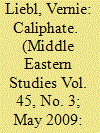

|
|
|
|
|
| Publication |
2009.
|
| Summary/Abstract |
The Caliphate was abolished 85 years ago; there have been several attempts to resurrected it since. What is the potential for a restoration of the caliphate? A new caliphate was declared in Ramadi in mid-2006 by Islamic insurgents before being quickly crushed by the Iraqi government. Just what exactly is a caliphate, who says there is one or who wants one (for example, both the Americans and Islamists have views on the caliphate) and the ideological justifications for one. Where and how did the caliphate begin, what are the prerequisites to be caliph (according to Muslim sources) and were or are there troubles in the succession? Has there been more than one caliphal dynasty? Who are the heirs, pretenders and illegitimate claimants? Where do such families such as the Moroccan Alaouite royal family, the House of Osman, the exiled-Nizamat of Hyderabad and the Hashemite dynasty of Jordan fit in? Despite there not being a 'legally' recognized Caliphate today, there are existing proto-caliphate structures, such as the Arab League and the Organization of the Islamic Conference. There are also legitimizing legal foundations, such as declarations recorded by the 1926 al-Azhar Caliphate Conference, enabling the possibility of a modern restoration of a caliphate.
|
|
|
|
|
|
|
|
|
|
|
|
|
|
|
|
| 3 |
ID:
089117
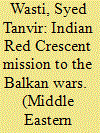

|
|
|
|
|
| Publication |
2009.
|
| Summary/Abstract |
Indian Muslim political development during the early years of the twentieth century contained a significant pan-Islamic component of solidarity, especially with the peoples of the beleaguered Ottoman Empire. Although this sentiment was later to be channelled into organized internal political activity such as the foundation of the Muslim League, it had its beginnings in various agitations such as the Khilafat Movement. The Indian Red Crescent Mission to Turkey may be said to have provided the initial mise-en-sc ne for the expression of political sympathy towards Turkey and the generation of a local freedom movement among the Muslims of India.
|
|
|
|
|
|
|
|
|
|
|
|
|
|
|
|
| 4 |
ID:
089118
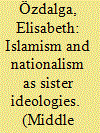

|
|
|
|
|
| Publication |
2009.
|
| Summary/Abstract |
Islamism and nationalism are usually regarded as opposites. The main purpose of this article is to question that notion. Instead of conceptualizing these two clusters of ideologies as standing in contradiction to each other, it may be worthwhile to look for affinities between them. That argument is based on an analysis of the doctrine of sovereignty as it underlies modern nationalism (congruence between the state and nation) and how this idiom shows signs of similarities to the theory of the classical caliphate (congruence between the ruler and ummah). When modern nationalism enters the political scene of the Muslim Middle East, Islamic heritage will constitute an important element of the way the nation, in relation to the state, will come to be articulated. The article starts by discussing developments in three countries where the relationship between Islamism and nationalism has been sufficiently evident (Egypt, Iran, and Turkey), and concludes with a discussion of the need for a theory of modernity, especially when tracing the historical roots of modern ideologies such as nationalism and Islamism.
|
|
|
|
|
|
|
|
|
|
|
|
|
|
|
|
| 5 |
ID:
089122
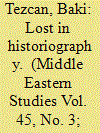

|
|
|
|
|
| Publication |
2009.
|
| Summary/Abstract |
This article tackles the question of why an attempt to uncover an indigenous history of limited government in the early modern Ottoman Empire has not been undertaken in twentieth-century Turkish historiography despite the obvious existence of several constituents for such a history, such as the political power and prestige of jurists (ulema), the political role of the janissary corps, and the many depositions and other revolts that they staged in cooperation with the jurists, which, in practice, limited the political authority of the sultan. The answer suggested by the article focuses on the political concerns of the early republic, the socio-economic concerns of the Muslim democrats currently in power, and the theoretical concerns of contemporary western historians who have been influenced by Edward Said's critique of Orientalism.
|
|
|
|
|
|
|
|
|
|
|
|
|
|
|
|
| 6 |
ID:
089115
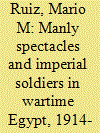

|
|
|
|
|
| Publication |
2009.
|
| Summary/Abstract |
This essay examines the relationship between Indian and Australasian soldiers and colonial Egyptians from 1914-19. Drawing upon memoirs, letters, and the work of Nagib Mahfuz, I argue that the First World War reaffirmed British military rule in Egypt and also posed a danger to it in the form of disorderly soldiers. Because British officials feared the unruly conduct of their troops they promoted manly ideals of self-control to facilitate their control over Egyptian society. Uncontrolled spectacles of wartime violence were therefore critical to the ways in which the British Army deployed masculine behaviour in the service of the colonial state.
|
|
|
|
|
|
|
|
|
|
|
|
|
|
|
|
| 7 |
ID:
089120


|
|
|
|
|
| Publication |
2009.
|
| Summary/Abstract |
This article explores the relationship between agricultural development and population growth in Iran in the nineteenth century. Had there been any national census data, the issue under consideration could have been examined in detail, but no such data is in existence. The article therefore offers historical evidence in support of the view that in Iran, population could not grow without sufficient investment in the provision of water, being essential for settled agriculture. Following from this, as this investment was not forthcoming, it is most likely that Iran experienced a downward demographic trend for most of the nineteenth century. The northern provinces, free from this constraint, seemed to have had a different experience. However, evidence is offered in the text indicating that even in these provinces the growth of population was unlikely to have been substantial.
|
|
|
|
|
|
|
|
|
|
|
|
|
|
|
|
| 8 |
ID:
089119


|
|
|
|
|
| Publication |
2009.
|
| Summary/Abstract |
This paper is aimed at introducing the inter-war dimension to the debate on the history of Turkey's association with the idea of European integration. This association evolved in the context of two inter-war initiatives: Aristide Briand's European Union proposal within the framework of the League of Nations and Richard Coudehove-Kalergi's Pan-Europe idea. Although Turkey had been originally excluded from both, the inter-war great power rivalries in Europe rectified the situation, allowing Turkey's incorporation into both schemes. In the process, the Turkish leaders and public could relate to Briand's intergovernmental initiative far more easily than to Coudenhove-Kalergi's Pan-Europe ideal. This might be considered a manifestation of traditional Turkish emphasis on institutional, rather than ideational, aspect of European integration.
|
|
|
|
|
|
|
|
|
|
|
|
|
|
|
|
|
|
|
|
|